A Land They No Longer Recognize
Desperation and resilience in hurricane-battered Puerto Rico
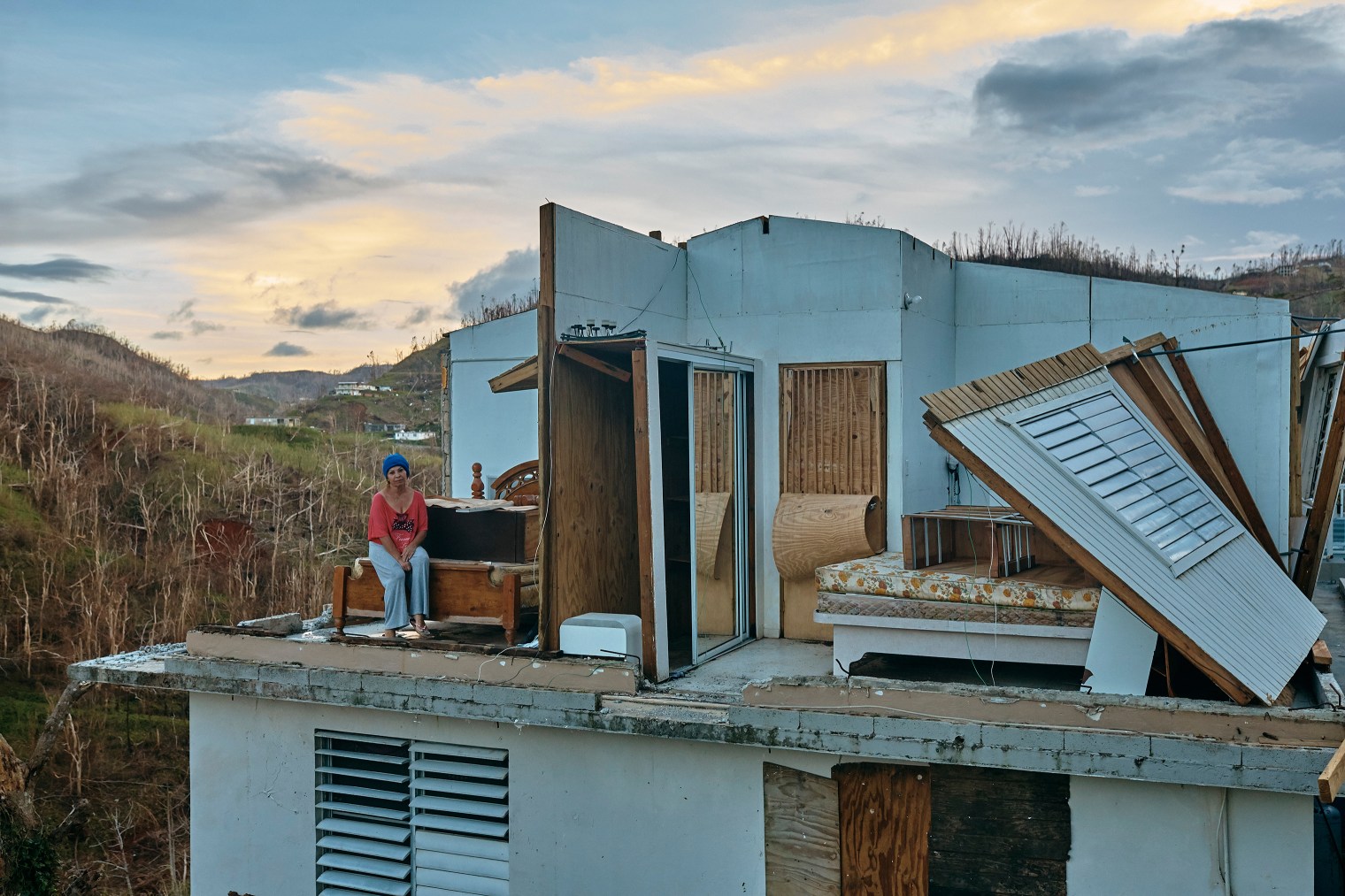 Wilmair Flores, 55, poses on a bed at her house in Barranquitas on Oct. 2. Andres Kudacki for TIME
Wilmair Flores, 55, poses on a bed at her house in Barranquitas on Oct. 2. Andres Kudacki for TIME
by Karl VicK | Photographs by Andres Kudacki for TIME
Ten days after Hurricane Maria roared across Puerto Rico, joggers circling the capital’s Condado lagoon were delighted by the sight of manatees, the gentle herbivores that sailors once mistook for mermaids. It’s not a routine sight in San Juan, and it was a rare uplifting one in a catalog of all the storm had laid bare: nearly every branch of every tree, with the interiors of homes opened like dollhouses—and, not least, the lopsided dynamic between Washington and the U.S. territory that might be best understood as America’s Last Colony.
Maria could be the most destructive Atlantic storm on record. Research by the Climate Impact Lab suggests that no larger area has been hit so comprehensively anywhere in the world in the past 60 years. Yet the storm somehow managed to reinforce one thing: the historically paternalistic relationship between mainland and island. The inequity became more pronounced with the passing of each muggy day in the storm’s aftermath. The federal government’s response was markedly slower and less attentive to Puerto Rico after Maria than to Texas after Harvey and Florida after Irma. And when the devastation finally came home to the White House, almost a week after Maria’s Sept. 20 landfall, what President Trump most conspicuously doled out to the victims was tart advice followed by angry remonstration.
To the victims of Harvey, Trump contributed $1 million from his personal fortune. But faced with far worse damage in Puerto Rico, he assumed the role of put-upon overseer. Trump framed the disaster on Sept. 25 by tweeting about the island’s financial debts. On Oct. 3, he opened what was intended as a healing visit by observing, “You’ve thrown our budget a little out of whack.” In between, he lambasted San Juan Mayor Carmen Yulín Cruz—“such poor leadership … they want everything to be done for them”—after she relayed Puerto Ricans’ complaints that aid was not reaching them.
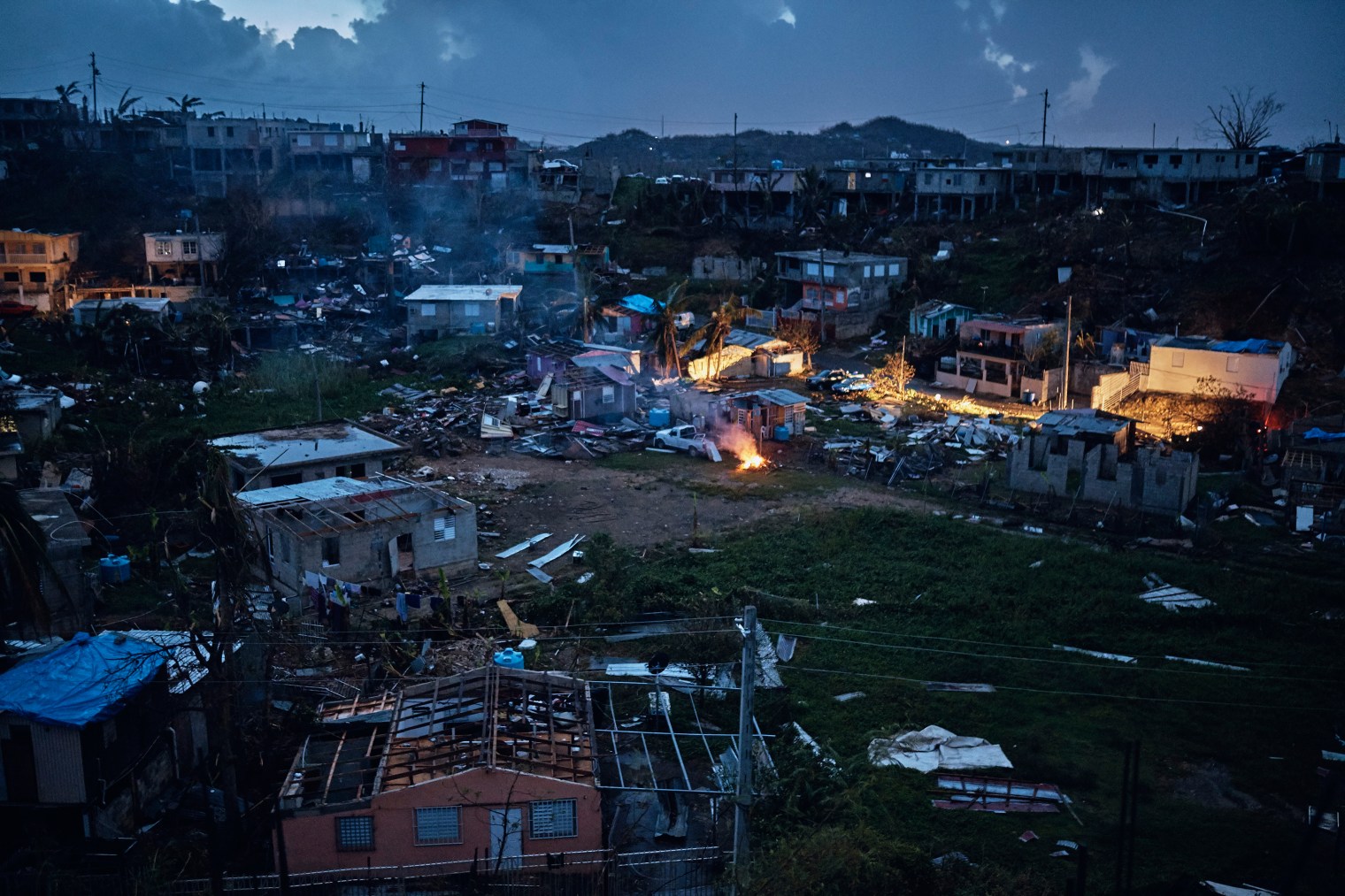 A man makes a fire after sunset in San Isidro, outside San Juan, on Sept. 28. Andres Kudacki for TIME
A man makes a fire after sunset in San Isidro, outside San Juan, on Sept. 28. Andres Kudacki for TIME
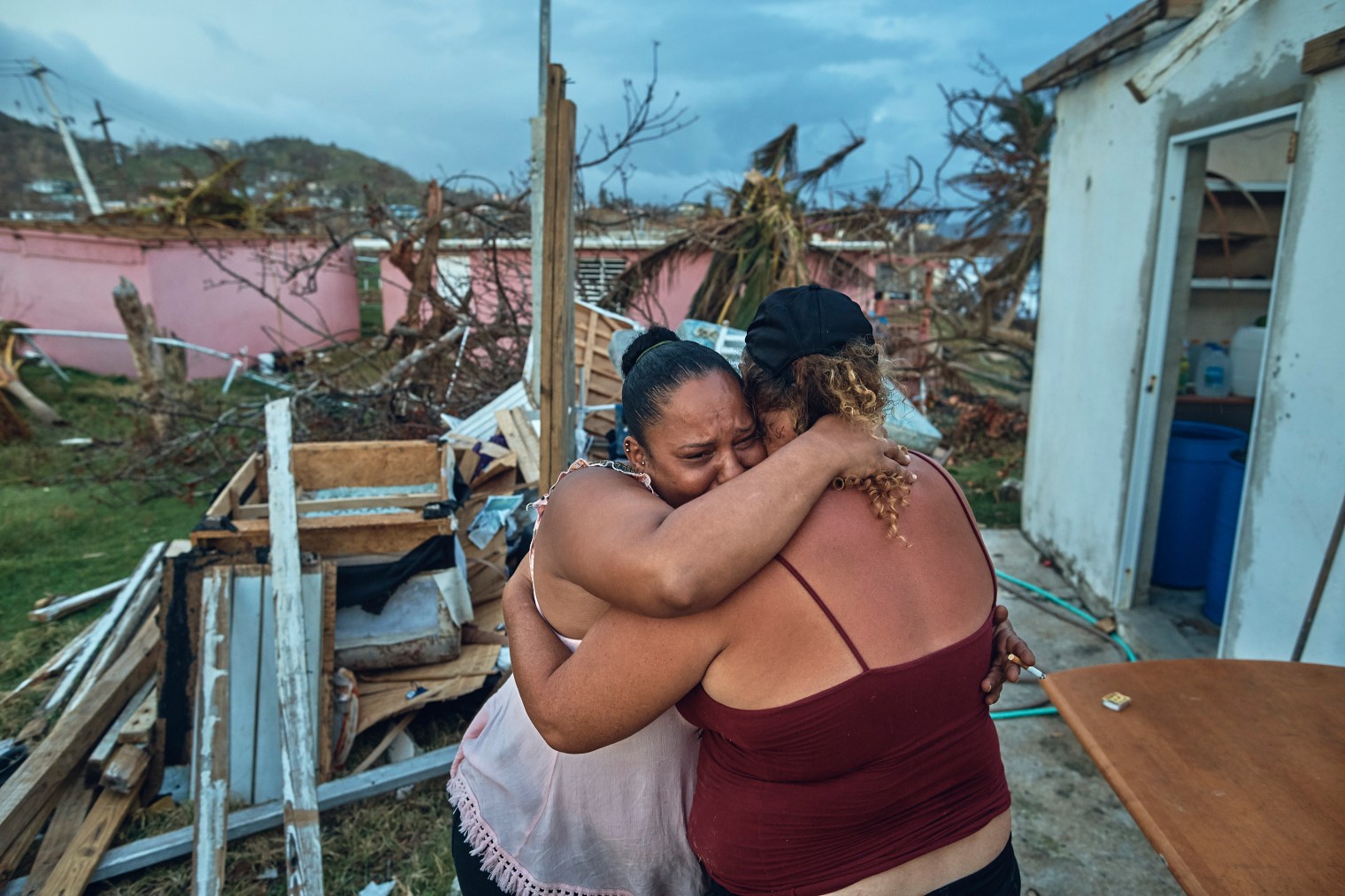 Sheila Sustache, 37, hugs her aunt Yasmin Morales Torres, 41, after seeing the damage to their houses in Yabucoa on Sept. 29. Andres Kudacki for TIME
Sheila Sustache, 37, hugs her aunt Yasmin Morales Torres, 41, after seeing the damage to their houses in Yabucoa on Sept. 29. Andres Kudacki for TIME
“Everything, I lost everything,” said Diego Rivera, in the poor San Juan neighborhood directly below the Spanish battlements that are the symbol of Puerto Rico. It was Oct. 1, 11 days after the storm ripped off his roof. “And we’re still waiting. They haven’t done nothing yet.”
What ends up being done, and how, is an especially momentous question for Puerto Rico because of how broken the island was even before the storm. Bankrupt but unable to escape its debts, its position at landfall was as fragile as the electrical grid that a year ago collapsed entirely on its own. For a decade, people have been leaving in historic numbers; more Puerto Ricans now live on the mainland than on the island, and Maria will accelerate the exodus. The Climate Impact Lab estimates that the storm could knock back per capita economic output by 21% over the next 15 years.
It’s possible the storm will underscore the message many Puerto Ricans have already absorbed: that a population of brown-skinned, Spanish-speaking Americans counts for less. Yet senior Puerto Rican officials reckon that, along with sea cows, the storm can also produce a fresh start. Trump himself provided the first evidence of the transformation during his trip. Speaking of the territory’s $72 billion debt, the President said, “We’re going to have to wipe that out.” He offered no details, and a recovery package is only just taking shape in Congress. But it was wind at the back of those urging both sides, supplicant island and historical master, to escape a shared history.
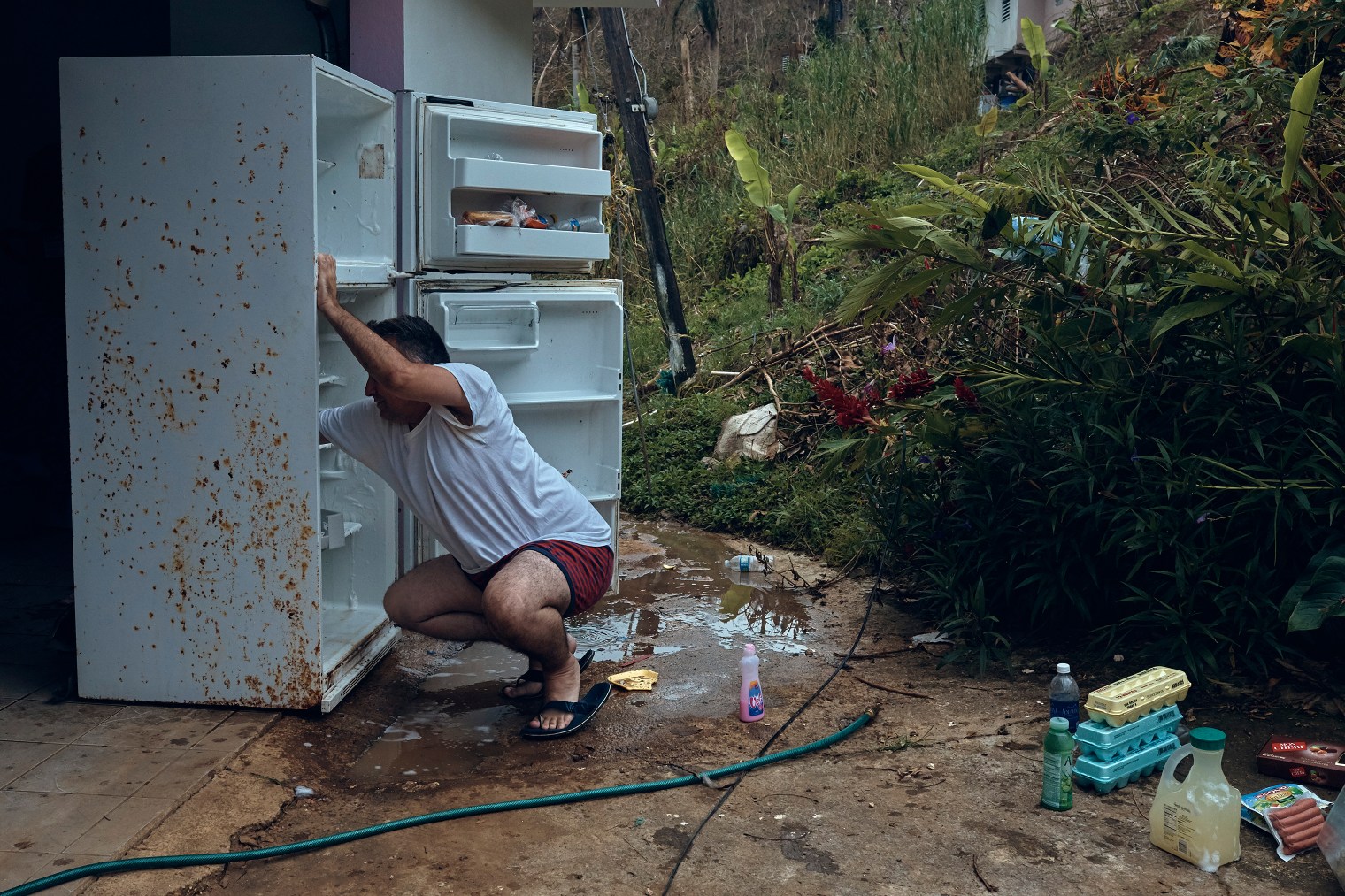 Gerardo Majero cleans his fridge in Morovis on Oct. 1. Andres Kudacki for TIME
Gerardo Majero cleans his fridge in Morovis on Oct. 1. Andres Kudacki for TIME
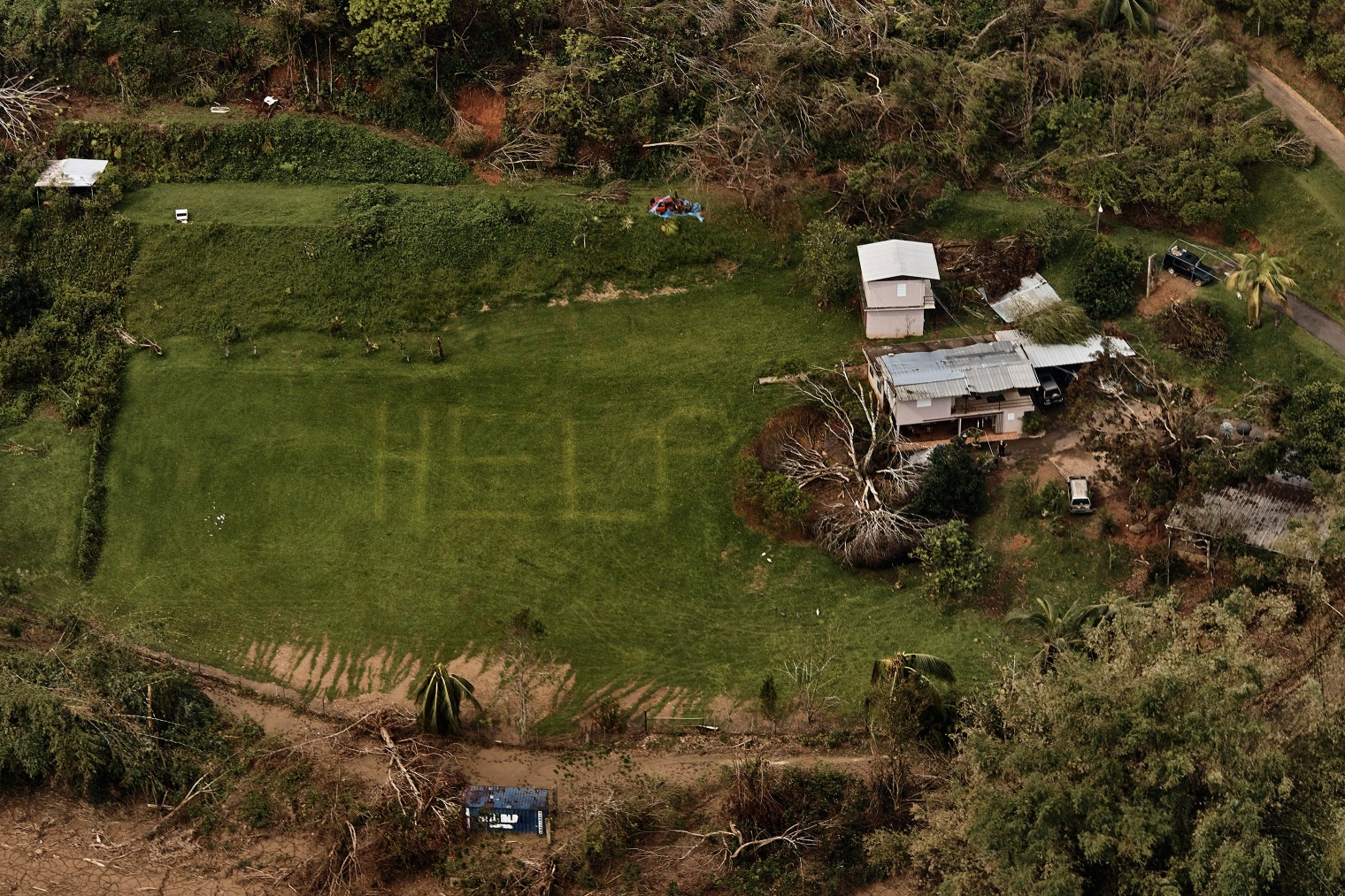 The desperate message ‘HELP’ is seen on the lawn of a home near Utuado in early October. Police who landed here found people without food or water. Andres Kudacki for TIME
The desperate message ‘HELP’ is seen on the lawn of a home near Utuado in early October. Police who landed here found people without food or water. Andres Kudacki for TIME
If Puerto Rico were a state, it would rank in area right around Connecticut, the nation’s richest. But in terms of income, it would displace Mississippi as the poorest of the poor. Six in 10 residents rely on public assistance.
“If we’re going to rebuild and reconstruct, it has to be for the right reasons,” says Cruz, the San Juan mayor. “We have to reshape our society. As awful as this has been, it’s an opportunity.” In her baseball cap and glasses, Cruz has been at the vortex of the political storm that followed the meteorological one. She called out FEMA and parried the fusillade from Trump. Yet even she hesitated to publicly broach the issue lurking behind the emergency: whether it can restore the island’s autonomy. “We are all shying away from that, because we don’t want the discourse to change,” she tells TIME. “We don’t want it to be about politics, we want it to be about lives.”
“Of course,” she adds, “politics affect lives.”
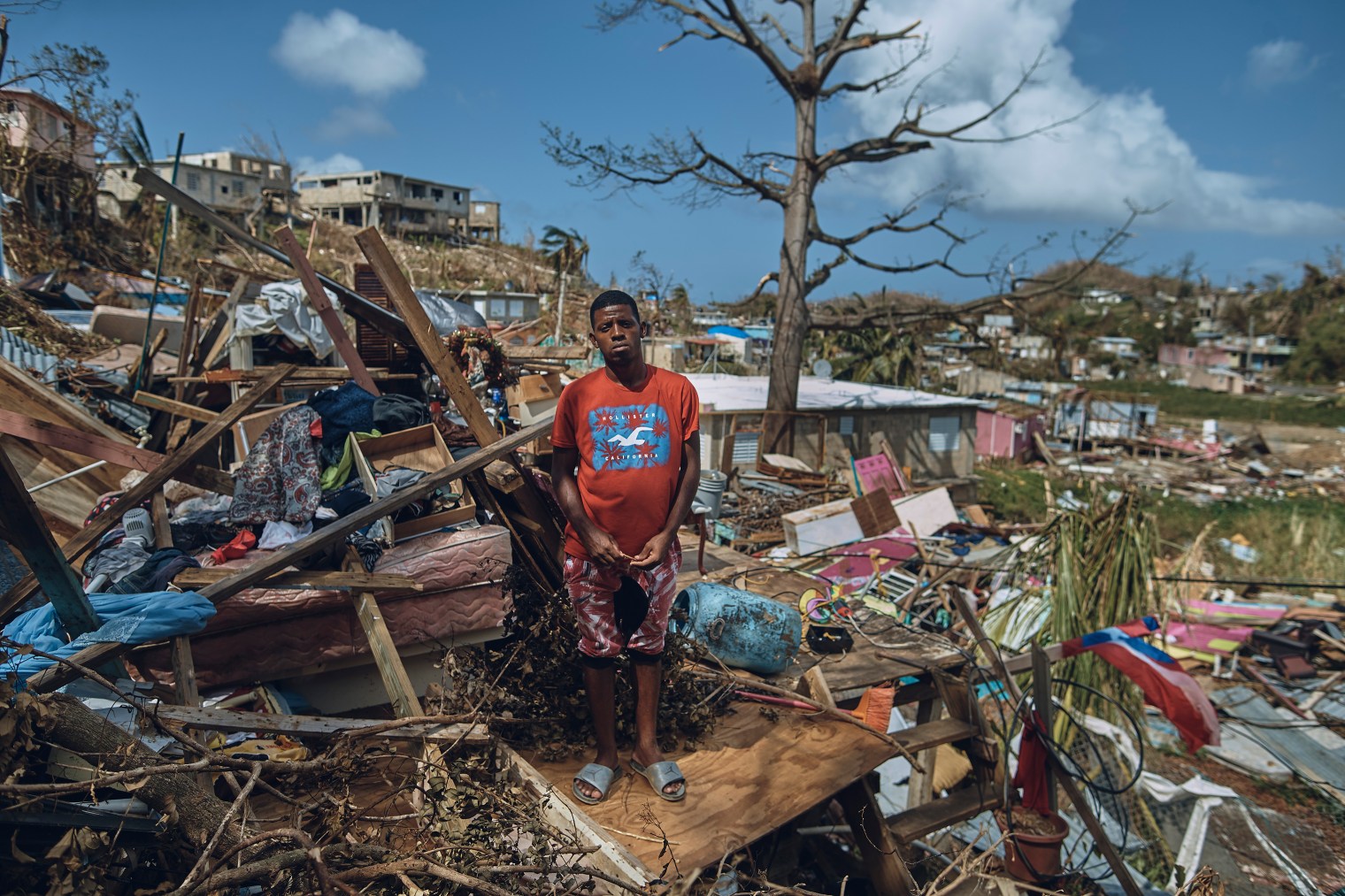 A man who has lived in San Isidro since he was nine years old stands for a portrait on Sept. 28. Andres Kudacki for TIME
A man who has lived in San Isidro since he was nine years old stands for a portrait on Sept. 28. Andres Kudacki for TIME
Puerto Rico began September in its usual place, on the dim edge of Americans’ awareness. Just after Maria made landfall, a poll found that nearly half of Americans did not know Puerto Ricans were U.S. citizens. That likely wouldn’t be true a month later, but the confusion is understandable, given the island’s muddy history with the mainland.
Claimed for Spain by Christopher Columbus on his second trip to the New World, Puerto Rico (“Rich Port”) was taken along with Cuba by the U.S. in the 1898 Spanish-American War. In no small part by choice, it has remained a part of the U.S. ever since. Repeatedly if narrowly, voters have opted for the status quo—a U.S. territory, though with ten times more people than the others combined. They are indeed citizens, but have no voting representative in Congress and cannot vote for President. Its “common-wealth” arrangement leaves Puerto Rico in the gray zone familiar in Latin America and the Caribbean, whose economic, political and intermittent military domination by the U. S. has been a fact of life ever since Monroe Doctrine. Only in Puerto Rico, it’s more direct.
When the U.S. Navy needed a bombing range, it put one off Vieques, an islet off the main island’s eastern shore. In 1976, Congress gave the island a financial boom by allowing companies to operate there tax-free. Twenty years later, the boom turned to crash after Congress withdrew the law. The island’s government continued to spend, however, bridging the growing chasm by issuing bonds it could not pay off. Legally unable to declare bankruptcy, it surrendered control of its finances, again by an act of Congress, to an oversight board appointed by the President. “This board is strangely reminiscent of the Executive Council, which ruled the island between 1900 and 1917,” writes Jorge Duany of Florida International University. Puerto Ricans call it the “junta.”
Then came Maria.
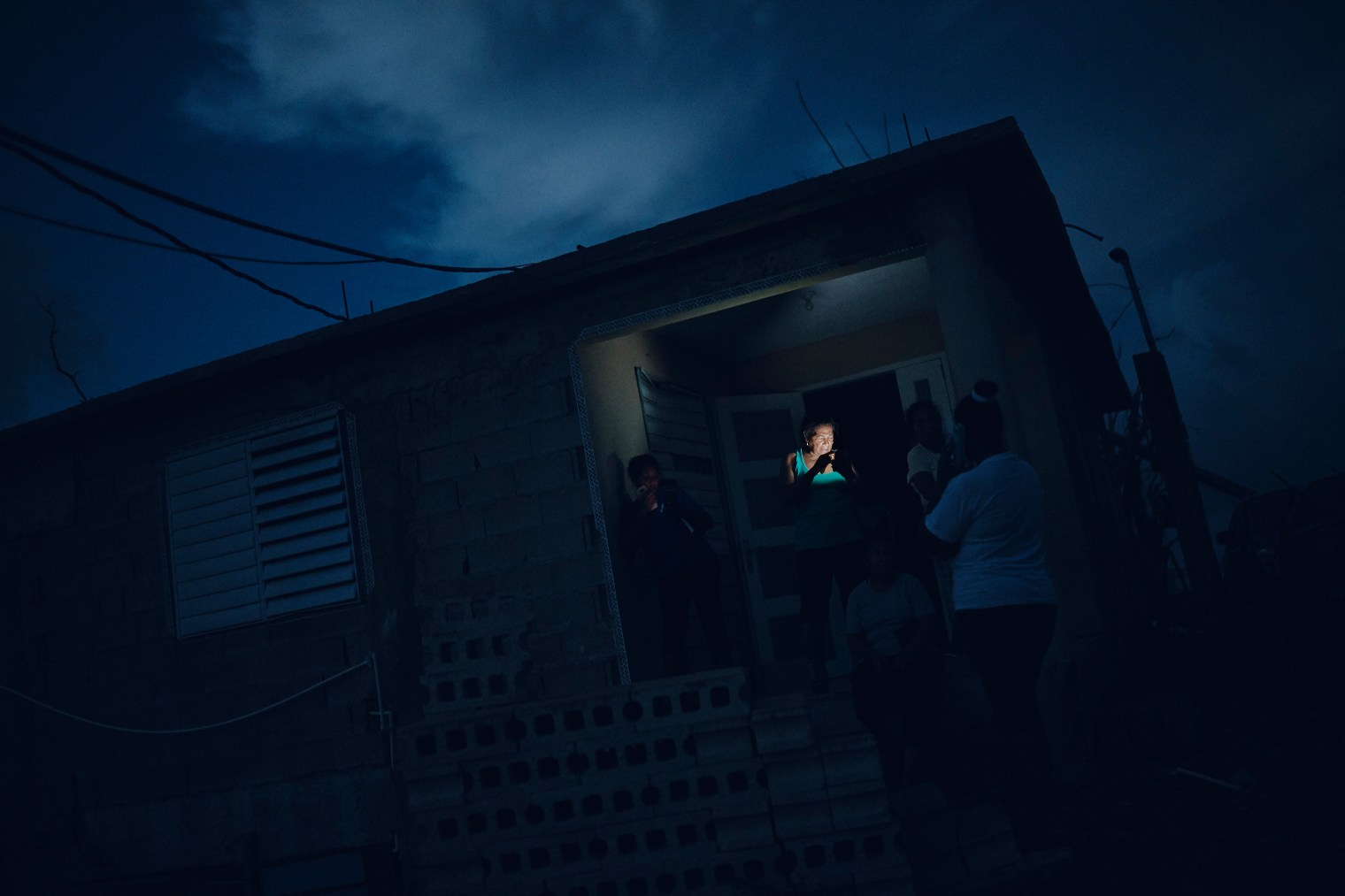 A woman’s face is illuminated by her mobile phone in San Isidro on Sept. 28. Andres Kudacki for TIME
A woman’s face is illuminated by her mobile phone in San Isidro on Sept. 28. Andres Kudacki for TIME
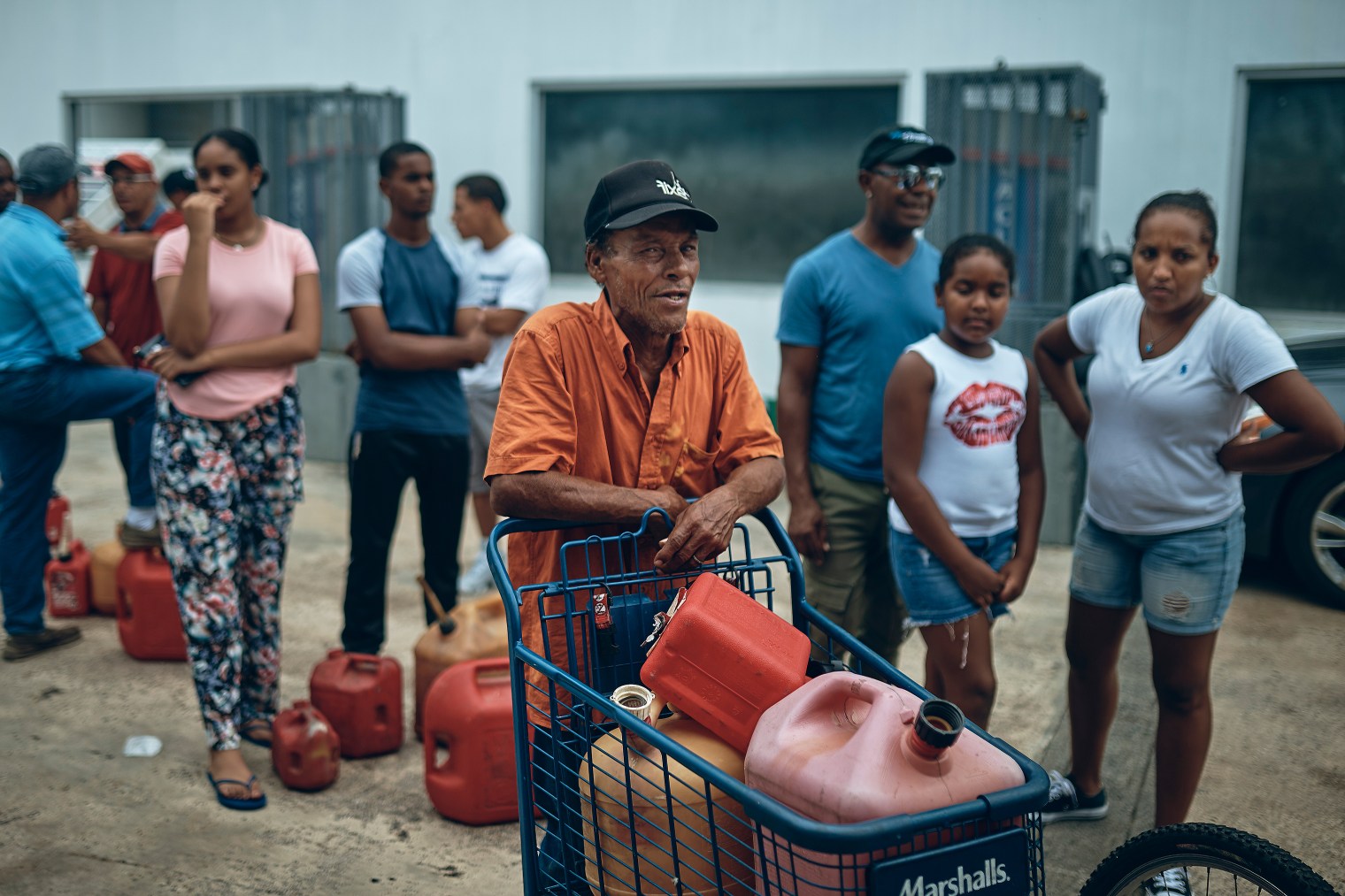 People wait in line to get fuel from a gas station in San Juan on Sept. 30. Andres Kudacki for TIME
People wait in line to get fuel from a gas station in San Juan on Sept. 30. Andres Kudacki for TIME
In one day, the storm utterly transformed the island physically. A landscape that had been a lush green was suddenly the dun and dull color of trees stripped of every leaf, even pine needles. Puerto Rico’s hillsides resembled Vietnam’s after titanic battles, ghostly moonscapes devoid of life. In greater San Juan, where half of the population lives, once-familiar vistas were so transformed that drivers lost their bearings, distracted by buildings that had been hidden by foliage or billboards no longer there.
Outside the city, where the storm hit hardest, only the freeway cloverleafs showed growth—their shoulders crowded with cars parked so the driver could grab the signal from a rare operating cell tower above the exit. Along with the creaking electrical grid, Maria took down the water supply. In Río Grande a week after the storm, a woman was shampooing her hair above rapids where a bald man washed his socks.
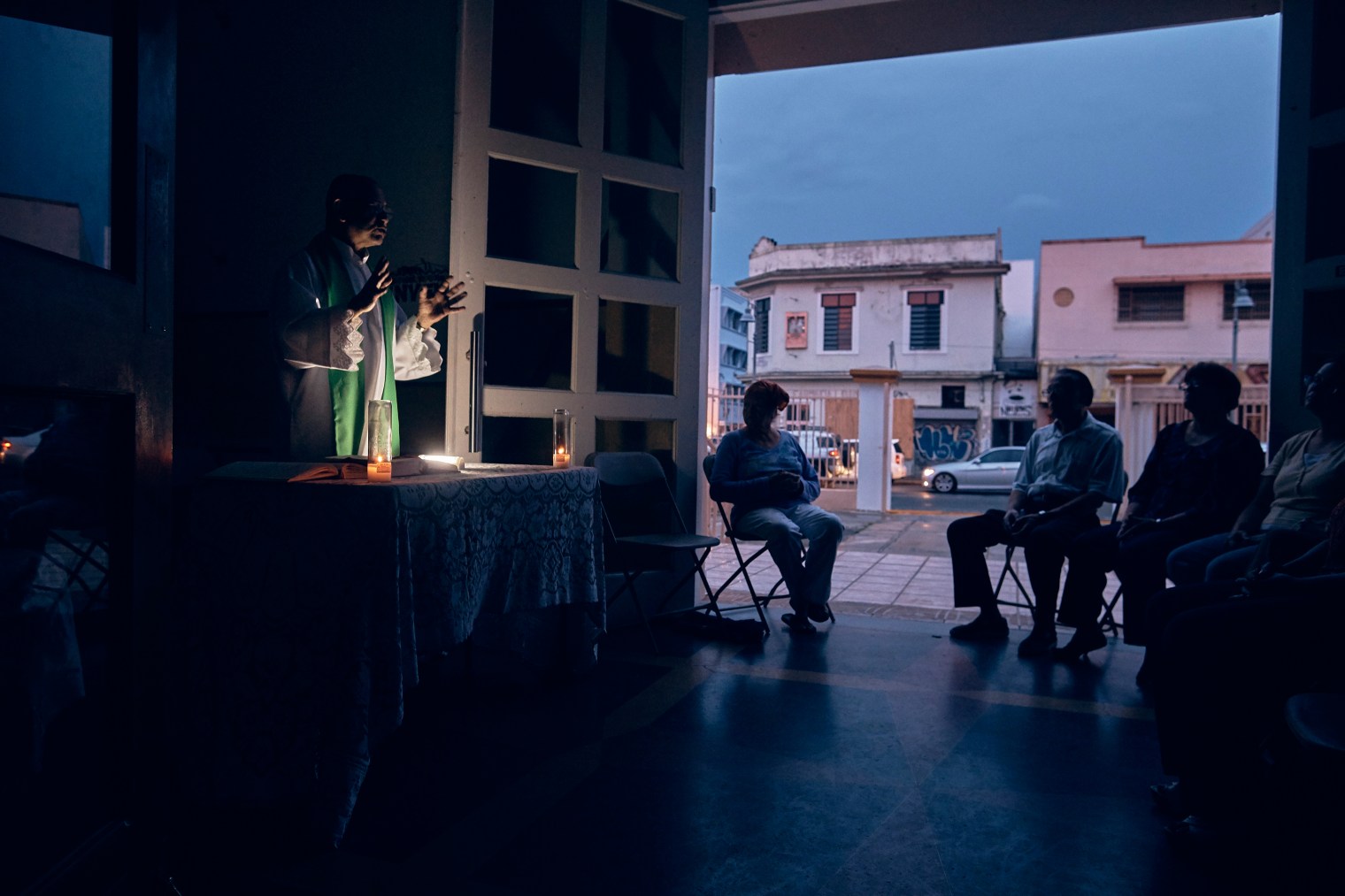 A priest talks during mass at a church in Santurce, a district of San Juan, on Sept. 30. Andres Kudacki for TIME
A priest talks during mass at a church in Santurce, a district of San Juan, on Sept. 30. Andres Kudacki for TIME
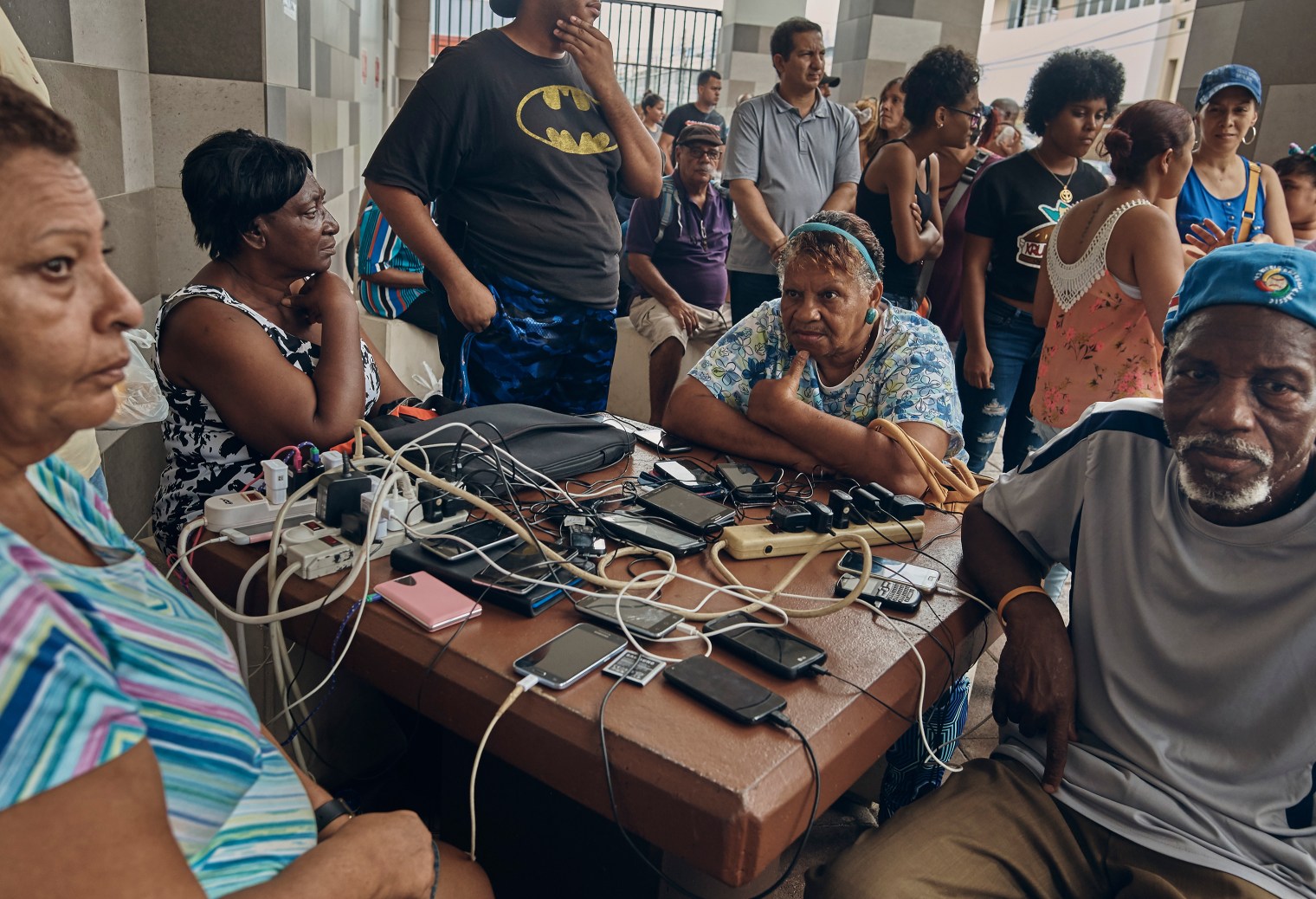 People charge their phones in San Juan on Sept. 30. Andres Kudacki for TIME
People charge their phones in San Juan on Sept. 30. Andres Kudacki for TIME
At 16 deaths, the official casualty toll is both subject to revision and astonishingly low. It testifies to efforts of island officials who placed their faith in minute-by-minute forecasts, rather than the prayers that some local preachers had urged to keep up the island’s previous extraordinary record of near-misses. Maria stayed the course. Officially 2 m.p.h. shy of Category 5 at landfall on the south-eastern shore, she raked the entire island. There was no intact corner from which to stage a recovery effort.
“We were completely disconnected,” says Governor Ricardo Rosselló, who spent the first days answering fresh emergencies: some 2,000 people were rescued from flash floods, then a damaged dam required a massive evacuation.
The feds had their own excuses for a late start. San Juan’s port and airport were both stricken, the main aviation radar damaged atop a wooded summit it took three days to reach. FEMA staff were on the island dealing with the far lighter damage from Irma, but as Trump observed, miles of open sea slowed everything. “There is a thing called the Atlantic Ocean,” Trump said on Sept. 26, the day after the magnitude of the disaster finally sank in at the White House. The tide was turned by TV images, plus reports from two senior officials who had just arrived on the island. Trump had spent the weekend in Bedminster, N.J., immersed in details of the latest travel ban and the feud he picked with the NFL.
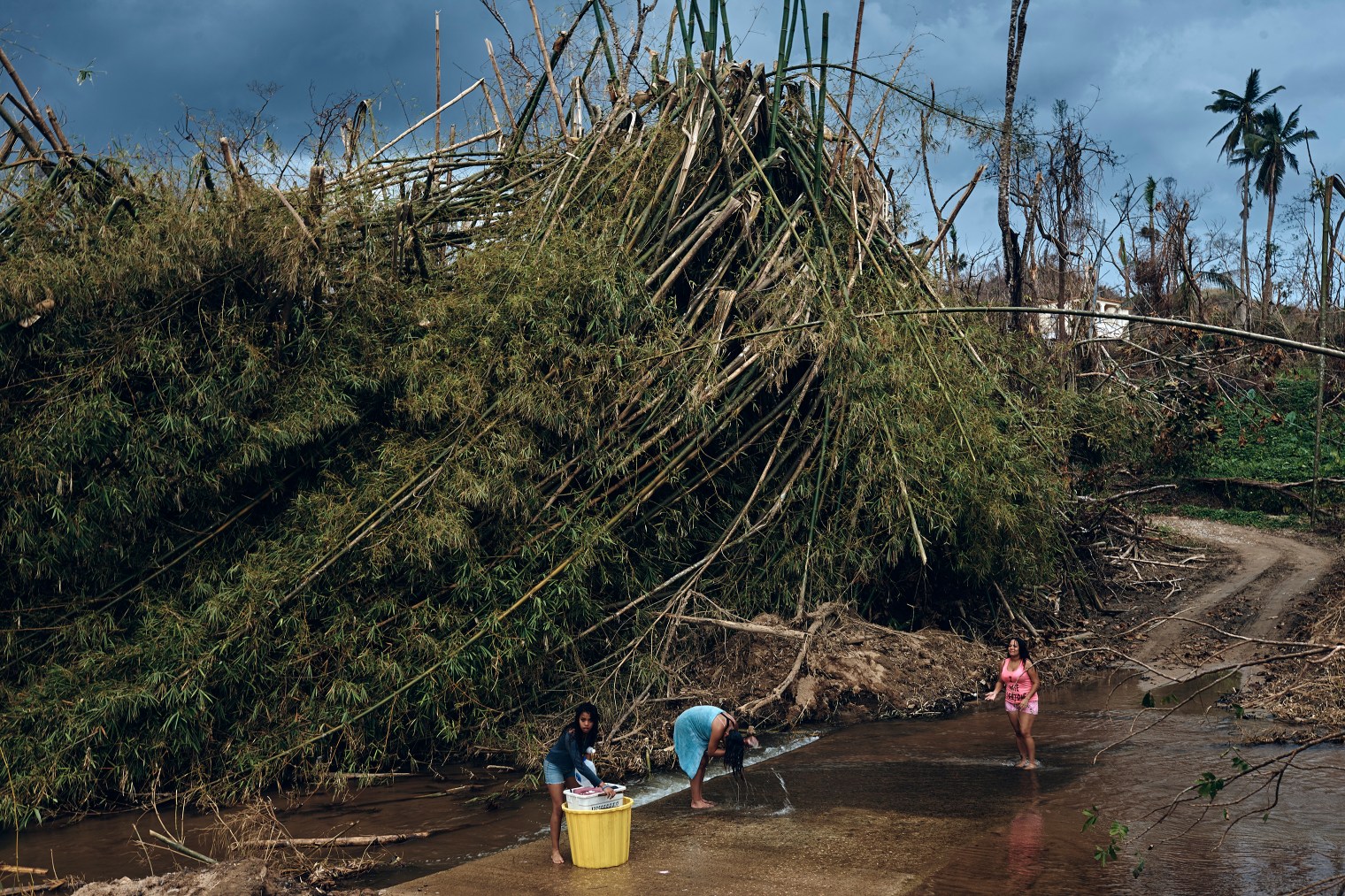 A family bathes in a river in Morovis on Oct. 1. Andres Kudacki for TIME
A family bathes in a river in Morovis on Oct. 1. Andres Kudacki for TIME
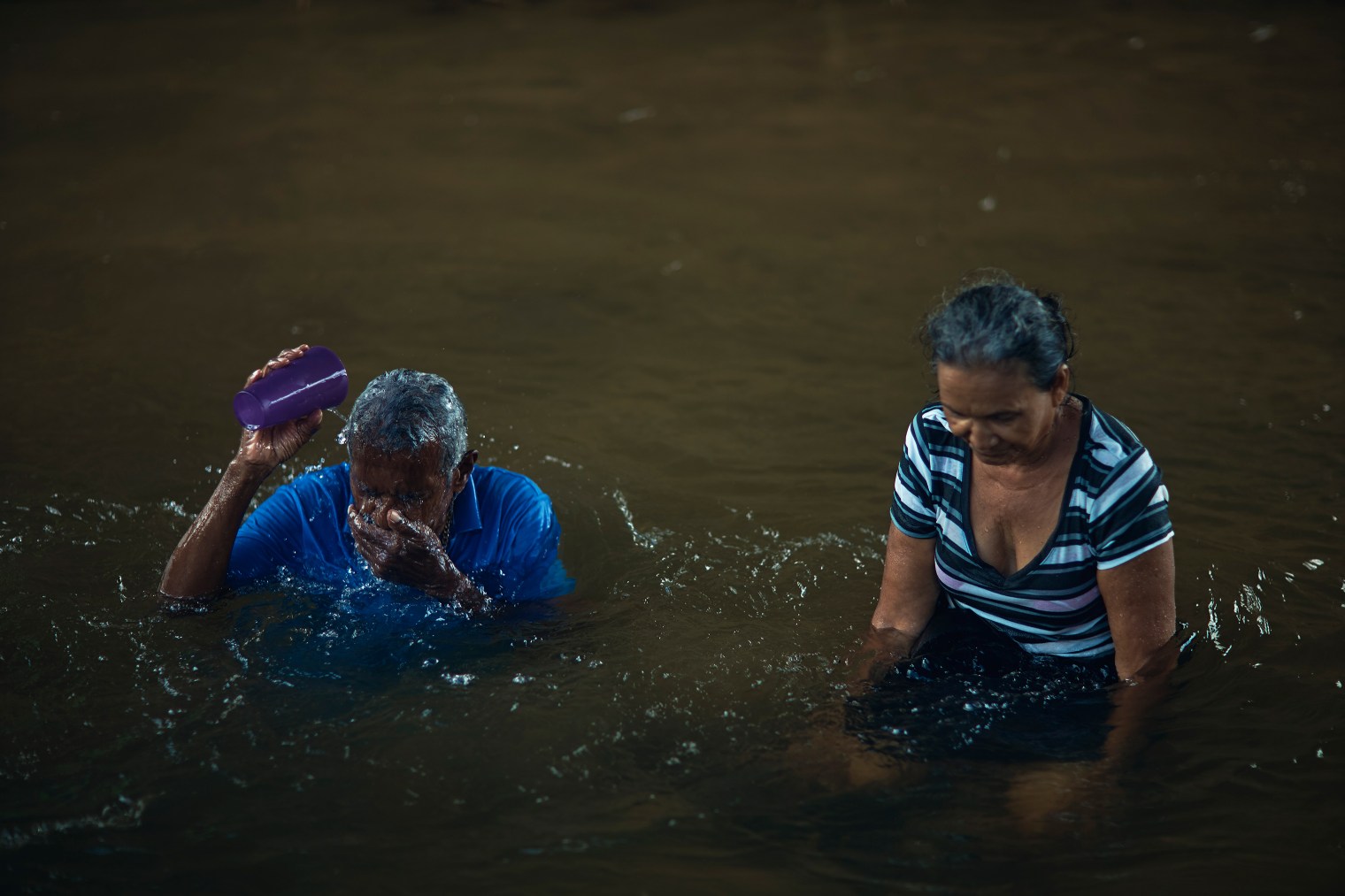 Luis Pinto, 73, and his neighbor Rosa Fernandez, 62, bathe in a river in Juncos on Sept. 29. Andres Kudacki for TIME
Luis Pinto, 73, and his neighbor Rosa Fernandez, 62, bathe in a river in Juncos on Sept. 29. Andres Kudacki for TIME
There’s no one way to provide aid after a disaster. When Maria hit, David Darg was in Mexico City, helping feed victims of the earthquake. Five days later, the vice president of Operation Blessing, a faith-based aid group, landed in San Juan with an aid shipment in the form of checked baggage—four crates of hand-size solar lights, ingenious creations that fold flat for charging during the day and pop open to provide eight hours of light. He came alone. “It’s been a season of disasters, and everyone’s stretched a little thin,” he says.
The official command center in Puerto Rico was a sleek and air-conditioned convention center that had every appearance of a well-run machine, from laminated IDs to computer graphic signboards. At daily news conferences, Rosselló, flanked by FEMA officials and a three-star general, read out the metrics—another million meals at the port, another 5,000 troops. The only problem was almost none of it seemed to be reaching the countryside. Or even neighborhoods down the street.
The bottleneck was truckers. With hundreds of cell towers down, Rosselló tells TIME, “We couldn’t communicate to let them know we needed them.” They’d had the same problem reaching the territory’s 78 mayors, who were to carry the aid from 11 distribution points and get it to their constituents. Trying to reach them by cell, they’d reached just six.
Then someone had a thought: radio. The medium that had been a lifeline in disasters for decades would move the Maria response off the dime. Radio stations broadcast a summons to mayors. and 55 showed up the next day. When truckers heard the call, goods finally started leaving the port. Between Sept. 29 and 30, Rosselló says, the number of trucks doubled from 400 to 800.
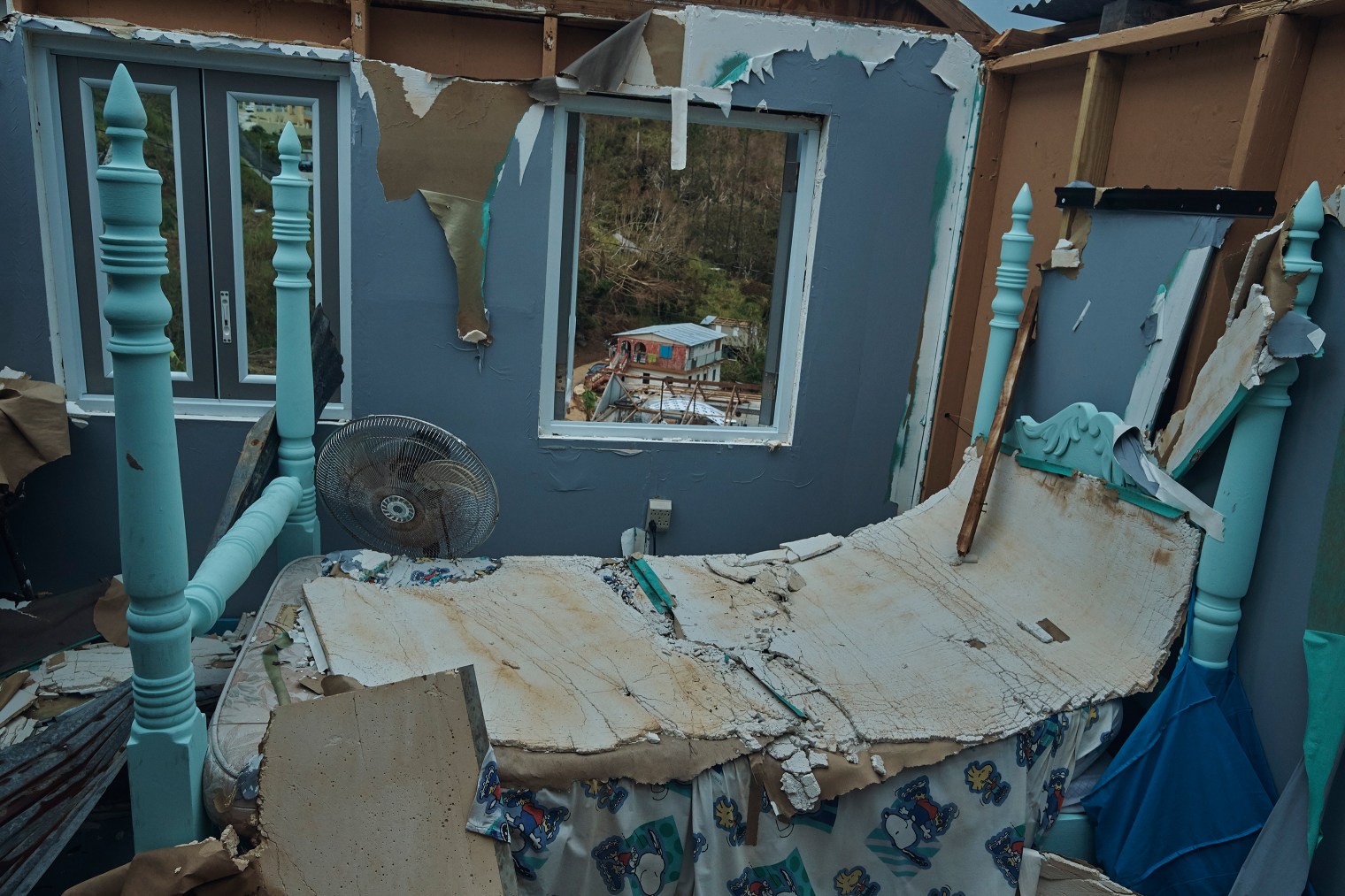 A bedroom in the destroyed home of Arnaldo Diaz Martinez in Orocovis on Oct. 1. Andres Kudacki for TIME
A bedroom in the destroyed home of Arnaldo Diaz Martinez in Orocovis on Oct. 1. Andres Kudacki for TIME
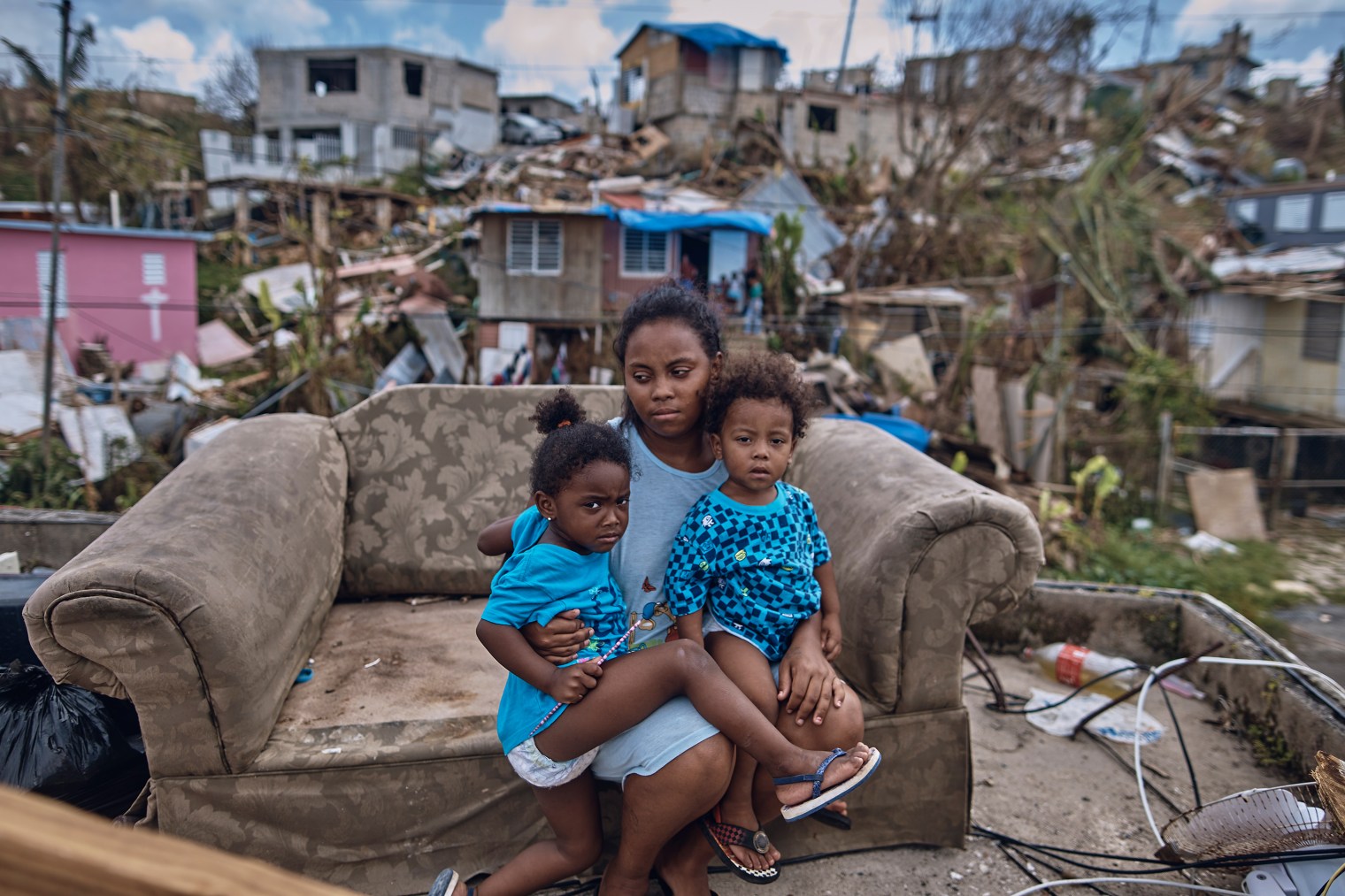 Darieliz Michelle Lopez, her 20-month-old son and three-year-old daughter sit on a sofa where her apartment stood in San Isidro on Sept. 28. Andres Kudacki for TIME
Darieliz Michelle Lopez, her 20-month-old son and three-year-old daughter sit on a sofa where her apartment stood in San Isidro on Sept. 28. Andres Kudacki for TIME
It was too late, however, to salvage the political disaster. By then, acting DHS secretary Elaine Duke had called the stalled operation “really, a good news story.” Watching on CNN, Mayor Yulín struggled visibly to contain her reaction. “Dammit, this is not a good news story,” she said. “This this is a ‘people are dying’ story.”
The relief operation Yulín mounted from the arena named for Robert Clemente (the baseball legend who died delivering earthquake relief to the island) doubled as an insurgency. “I just do not understand why FEMA can’t seem to find their way out of a paper bag,” she said on Sept. 29, amid pallets of canned goods and pampers contributed by businesses. The next day, FEMA had sent over several pallets as well, and it was being all packed into boxes as Yulín faced a stream of camera crews. Trump had attacked her on Twitter for criticizing the flailing effort. “Politically motivated ingrates,” he wrote.
Yulín was fine with the attention, but declined to take the bait. “Seriously, I have more important things to do,” she told Senator Elizabeth Warren, when the Massachusetts Democrat called to ask what Congress should do for Puerto Rico. Yulín brought up the Jones Act, a 1920 statute unknown to most Americans but a household term in Puerto Rico. Yulin says it raises prices on the island by 30 percent, because it bars from its shores any vessel that has not docked first at another U.S. port. Trump suspended it to help the aftermath of Irma and Harvey, but at first hesitated to give Puerto Rico the same break, explaining “there are a lot of people who work in the shipping industry that don’t want the Jones Act lifted.”
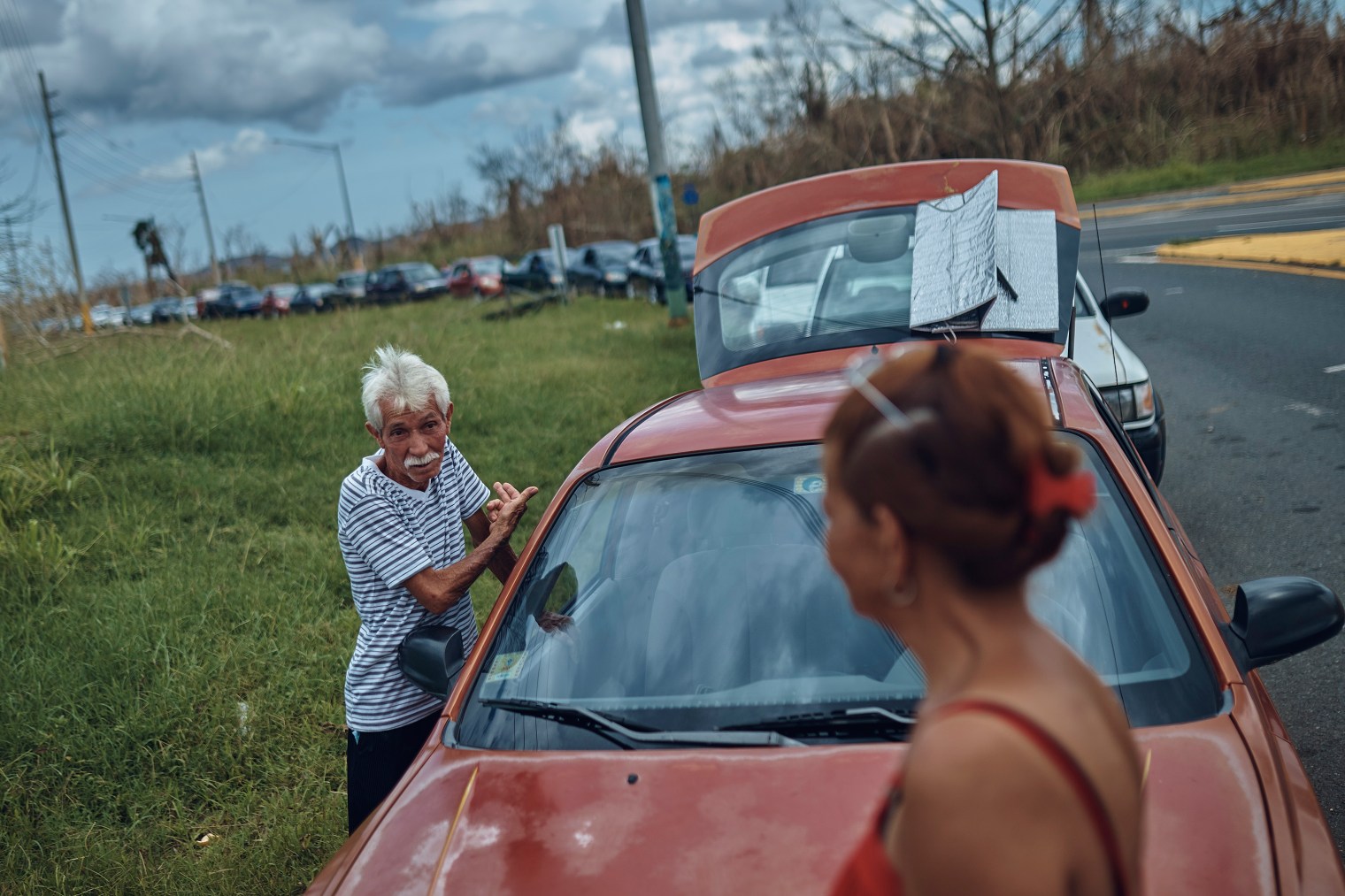 People wait in line to buy gasoline in Morovis on Oct. 1. Andres Kudacki for TIME
People wait in line to buy gasoline in Morovis on Oct. 1. Andres Kudacki for TIME
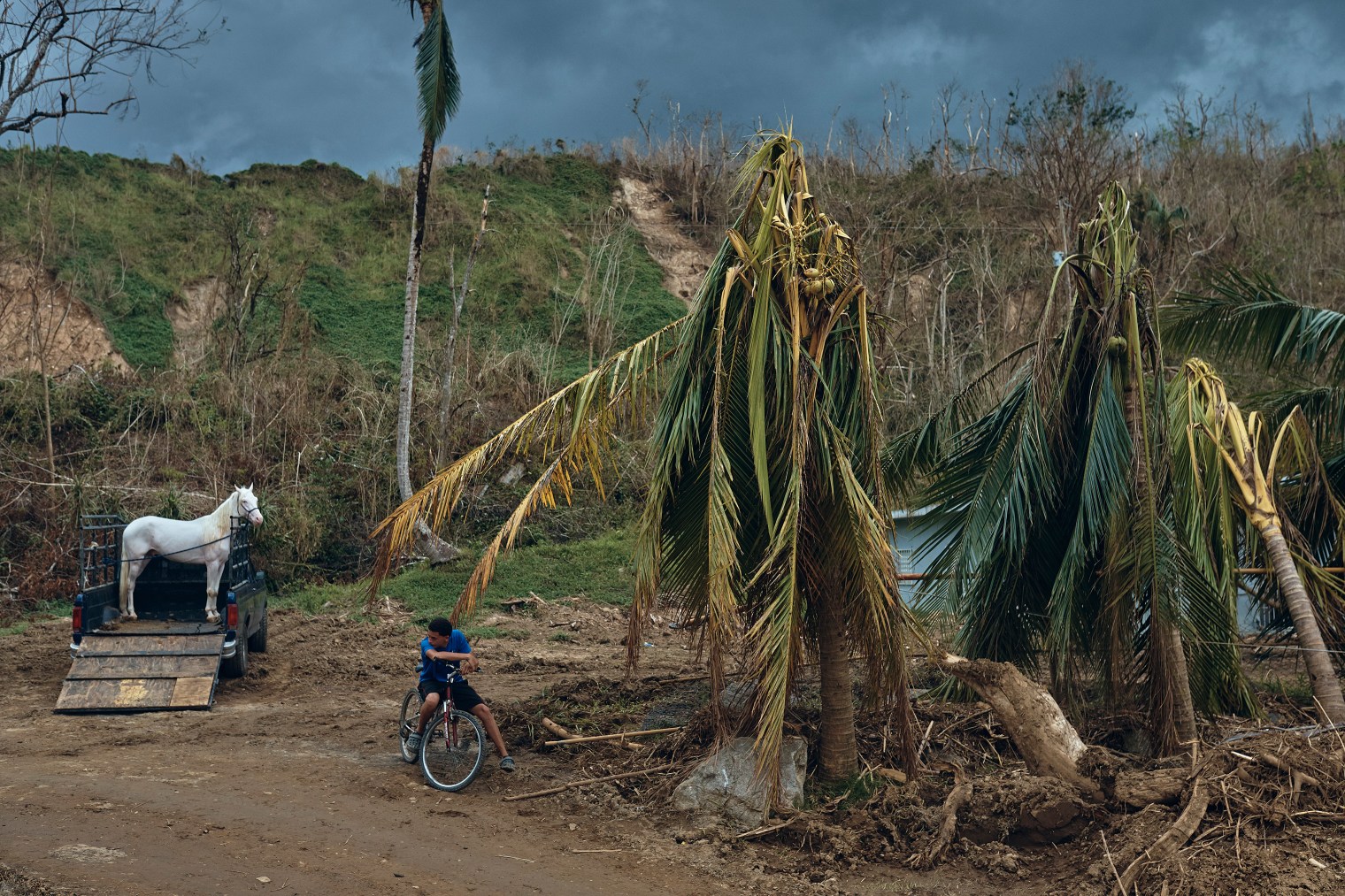 A man waits near a damaged bridge in Morovis on Oct. 1. Andres Kudacki for TIME
A man waits near a damaged bridge in Morovis on Oct. 1. Andres Kudacki for TIME
On Capitol Hill, the President’s inelegance may actually help Puerto Rico. The Hispanic vote matters to House Republicans facing re-election in competitive districts, and as the recovery package takes shape, political benefit may flow from taking the side of the shattered island. In any event, only a massive infusion of federal funds will produce the kind of reconstruction that, as Rosselló put it, “shows a way forward, to make of this catastrophe in the long term a story of rebuilding, rethinking and putting Puerto Rico in the vanguard.”
It may not even be wishful thinking. If both mainland and island agree it’s possible, a new future could be sketched on a slate, and a territory, that Maria wiped clean. — With reporting by Massimo Calabresi, Elizabeth Dias, Philip Elliott and Zeke J. Miller/Washington; and Tara John/London
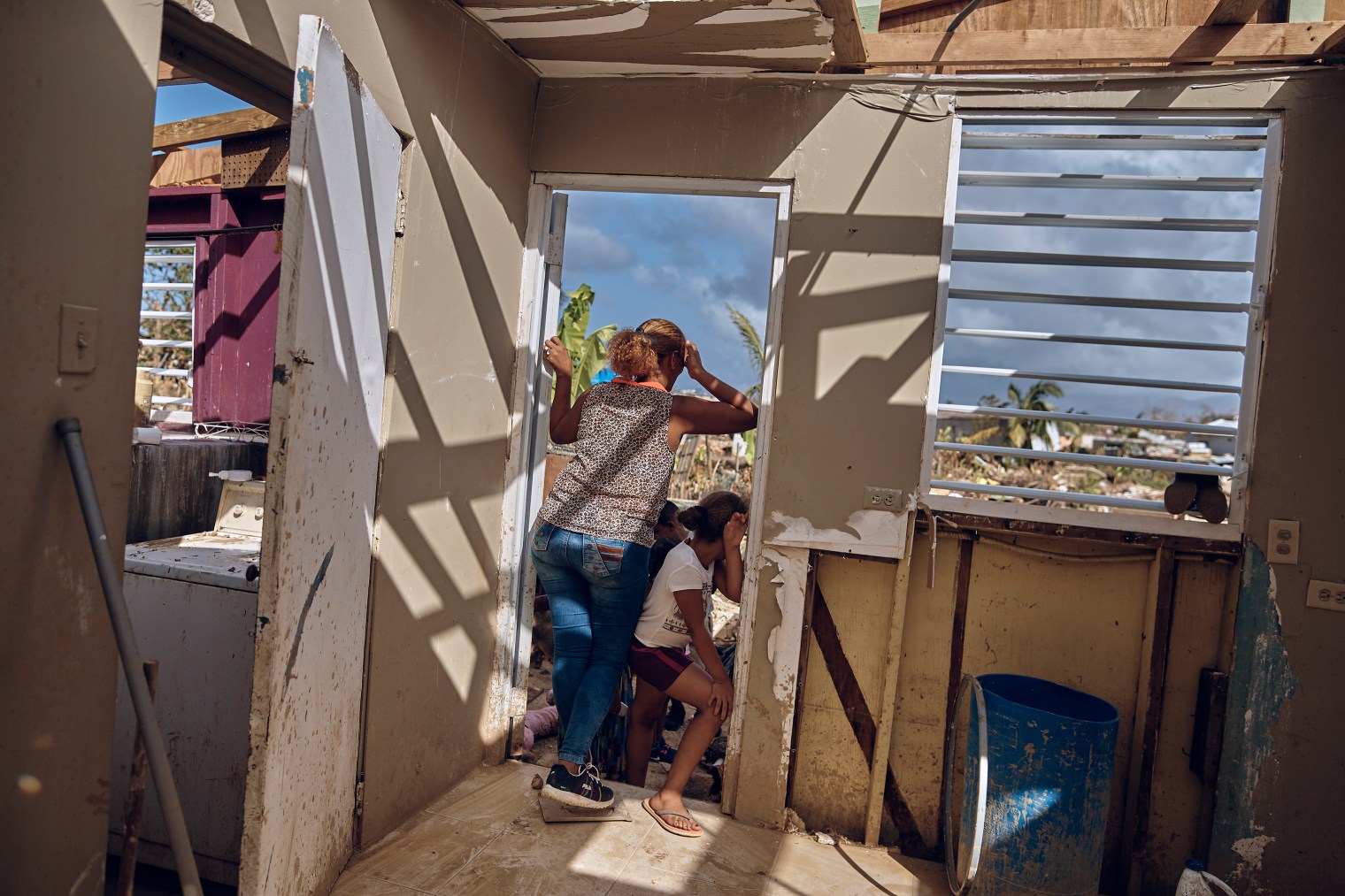 A woman looks outside from her damaged house in San Isidro on Sept. 28. Andres Kudacki for TIME
A woman looks outside from her damaged house in San Isidro on Sept. 28. Andres Kudacki for TIME
Andres Kudacki is a photographer based in New york. Follow him on Instagram @andreskudacki.